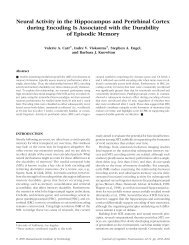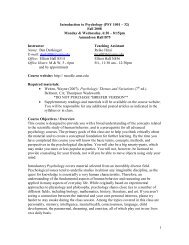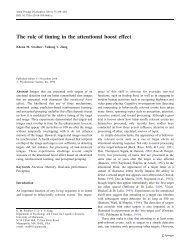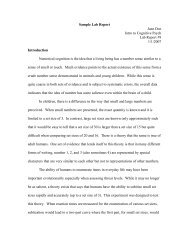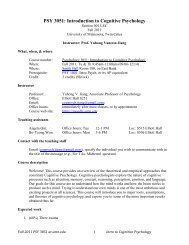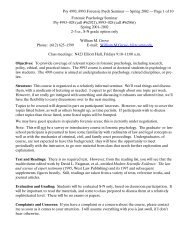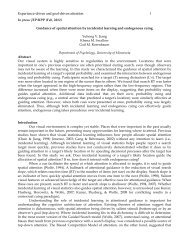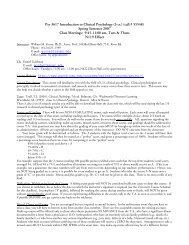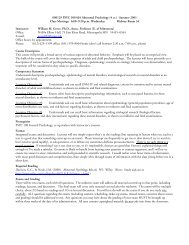Distributing versus focusing attention in visual short-term memory
Distributing versus focusing attention in visual short-term memory
Distributing versus focusing attention in visual short-term memory
You also want an ePaper? Increase the reach of your titles
YUMPU automatically turns print PDFs into web optimized ePapers that Google loves.
Psychonomic Bullet<strong>in</strong> & Review<br />
2007, 14 (6), -<br />
<strong>Distribut<strong>in</strong>g</strong> <strong>versus</strong> <strong>focus<strong>in</strong>g</strong> <strong>attention</strong><br />
<strong>in</strong> <strong>visual</strong> <strong>short</strong>-<strong>term</strong> <strong>memory</strong><br />
Tal Makovski and Yuhong V. Jiang<br />
Harvard University, Cambridge, Massachusetts<br />
Visual <strong>short</strong>-<strong>term</strong> <strong>memory</strong> (VSTM) is traditionally considered a robust form of <strong>visual</strong> <strong>memory</strong> resistant<br />
to <strong>in</strong>terference from subsequent <strong>visual</strong> <strong>in</strong>put. This study shows that the robustness of VSTM depends on the<br />
way <strong>attention</strong> is allocated <strong>in</strong> VSTM. When <strong>attention</strong> is distributed across multiple <strong>memory</strong> items, VSTM for<br />
these items is vulnerable to <strong>in</strong>terference from subsequent <strong>in</strong>put, <strong>in</strong>clud<strong>in</strong>g passively viewed images and the<br />
postchange test<strong>in</strong>g displays. Yet <strong>attention</strong> can readjust its focus <strong>in</strong> VSTM on the basis of an <strong>attention</strong>al orient<strong>in</strong>g<br />
cue presented long after encod<strong>in</strong>g. When <strong>attention</strong> is oriented to a particular memorized item, the <strong>memory</strong><br />
is resistant to subsequent <strong>in</strong>terference. This effect, however, is elim<strong>in</strong>ated when the subset of items demand<strong>in</strong>g<br />
focal <strong>attention</strong> exceeds one, suggest<strong>in</strong>g that orient<strong>in</strong>g <strong>attention</strong> <strong>in</strong> VSTM is less flexible than orient<strong>in</strong>g <strong>attention</strong><br />
<strong>in</strong> perception. We propose that the robustness of VSTM is <strong>in</strong>fluenced by whether <strong>attention</strong> is focused or<br />
distributed <strong>in</strong> VSTM.<br />
Visual <strong>short</strong>-<strong>term</strong> <strong>memory</strong> (VSTM) reta<strong>in</strong>s objects and<br />
scenes for a few seconds after their disappearance (Luck<br />
& Vogel, 1997). Unlike iconic <strong>memory</strong>, which is disrupted<br />
by subsequent <strong>visual</strong> <strong>in</strong>put, VSTM is traditionally considered<br />
a robust form of <strong>visual</strong> <strong>memory</strong> whose contents can<br />
survive changes <strong>in</strong> screen location, eye position, observer<br />
motion, and object occlusion (Phillips, 1974). This view<br />
leads to the proposal that VSTM helps ma<strong>in</strong>ta<strong>in</strong> <strong>visual</strong><br />
stability by bridg<strong>in</strong>g across spatiotemporal <strong>in</strong>terruptions.<br />
However, recent studies have shown that contents <strong>in</strong> VSTM<br />
are highly vulnerable to <strong>in</strong>terference from subsequent displays,<br />
<strong>in</strong>clud<strong>in</strong>g images that require <strong>memory</strong> (Broadbent<br />
& Broadbent, 1981) or <strong>attention</strong> (Landman, Spekreijse, &<br />
Lamme, 2003) and images that are passively viewed (Makovski,<br />
Shim, & Jiang, 2006). In this study, we ask, is the<br />
robustness of VSTM modulated by selective <strong>attention</strong> If<br />
so, what are the boundary conditions for this modulation<br />
Extensive cognitive research has shown that selective<br />
<strong>attention</strong> can filter out irrelevant perceptual <strong>in</strong>put. Attention<br />
also de<strong>term</strong><strong>in</strong>es which subset of <strong>visual</strong> <strong>in</strong>put is<br />
encoded <strong>in</strong> VSTM (Schmidt, Vogel, Woodman, & Luck,<br />
2002). Nevertheless, few studies have <strong>in</strong>vestigated <strong>attention</strong>al<br />
selection of <strong>in</strong>formation already ma<strong>in</strong>ta<strong>in</strong>ed <strong>in</strong><br />
VSTM, perhaps because researchers usually assume that<br />
the contents of VSTM are already attended, and thus no<br />
further dist<strong>in</strong>ction needs to be made about the way <strong>attention</strong><br />
is allocated. An important exception is research<br />
conducted by Nobre and colleagues. They show that <strong>attention</strong><br />
can select <strong>in</strong>formation <strong>in</strong> VSTM just as it can select<br />
perceptual <strong>in</strong>formation (Griff<strong>in</strong> & Nobre, 2003; Lepsien,<br />
Griff<strong>in</strong>, Devl<strong>in</strong>, & Nobre, 2005). In Griff<strong>in</strong> and Nobre’s<br />
study, for example, an <strong>attention</strong>al orient<strong>in</strong>g cue is presented<br />
either before <strong>memory</strong> encod<strong>in</strong>g, or after <strong>memory</strong><br />
encod<strong>in</strong>g. The cue <strong>in</strong>forms observers which item will later<br />
be probed. Compared with no-cue trials, cu<strong>in</strong>g <strong>attention</strong> to<br />
the potential target <strong>in</strong>creases <strong>memory</strong> performance. This<br />
effect is found both when <strong>attention</strong> is directed <strong>in</strong> perceptual<br />
space (cue before <strong>memory</strong> encod<strong>in</strong>g), and when it is<br />
directed <strong>in</strong> VSTM (cue 2–12 sec after <strong>memory</strong> encod<strong>in</strong>g;<br />
Lepsien et al., 2005). To account for the benefit of orient<strong>in</strong>g<br />
<strong>attention</strong> <strong>in</strong> VSTM where all items are already attended,<br />
Griff<strong>in</strong> and Nobre propose that focused <strong>attention</strong><br />
enhances VSTM representation at the cued location. But<br />
<strong>in</strong> what respect is VSTM representation enhanced<br />
In a separate study, Landman et al. (2003) also discovered<br />
that retrospectively cu<strong>in</strong>g an item <strong>in</strong> VSTM enhances<br />
change detection performance. Landman et al. propose<br />
that <strong>visual</strong> <strong>in</strong>formation is <strong>in</strong>itially held <strong>in</strong> a high capacity<br />
store known as a cortical icon (Sligte, Lamme, & Scholte,<br />
2006), which is dist<strong>in</strong>guished from iconic <strong>memory</strong> by its<br />
long duration. This <strong>memory</strong> is easily <strong>in</strong>terfered with by a<br />
postchange test display, unless <strong>attention</strong> has already focused<br />
on one of the memorized items. Whether <strong>short</strong>-<strong>term</strong><br />
<strong>visual</strong> <strong>memory</strong> <strong>in</strong>deed conta<strong>in</strong>s an <strong>in</strong>itial phase of a highcapacity<br />
store rema<strong>in</strong>s controversial. However, Landman<br />
et al.’s study suggests that selective <strong>attention</strong> enhances<br />
VSTM representation by <strong>in</strong>creas<strong>in</strong>g its robustness to<br />
subsequent <strong>in</strong>terference. Although this proposal is plausible,<br />
it lacks direct empirical evidence. Griff<strong>in</strong> and Nobre<br />
(2003) did not manipulate <strong>in</strong>terference directly, and Landman<br />
et al. simply assumed that <strong>in</strong>terference came from<br />
the postchange test display. Yet Landman et al. could not<br />
directly assess <strong>in</strong>terference effects because their test array<br />
served both as a probe for <strong>memory</strong> and as a source of<br />
T. Makovski, tal.makovski@gmail.com<br />
1 Copyright 2007 Psychonomic Society, Inc.
2 Makovski and Jiang<br />
<strong>in</strong>terference. This dual role made it impossible to obta<strong>in</strong> a<br />
basel<strong>in</strong>e measure where <strong>in</strong>terference was absent.<br />
This study aims to directly test the hypothesis that selective<br />
<strong>attention</strong> modulates the robustness of VSTM. We<br />
measured <strong>in</strong>terference <strong>in</strong> VSTM from a task-irrelevant<br />
array presented dur<strong>in</strong>g the retention <strong>in</strong>terval. If orient<strong>in</strong>g<br />
<strong>attention</strong> to an item <strong>in</strong> VSTM <strong>in</strong>creases its robustness, then<br />
<strong>in</strong>terference from the irrelevant array should be elim<strong>in</strong>ated<br />
when <strong>attention</strong> is focused on that item, but not when <strong>attention</strong><br />
is distributed widely across multiple items. A second<br />
goal of this study is to del<strong>in</strong>eate the boundary conditions<br />
under which VSTM robustness is enhanced by <strong>attention</strong>.<br />
Specifically, can <strong>attention</strong> enhance VSTM robustness when<br />
its focus is split among several <strong>memory</strong> items Whether<br />
<strong>attention</strong> has a s<strong>in</strong>gle or multiple spotlights is a longdebated<br />
question <strong>in</strong> vision research. Previous studies show<br />
that <strong>visual</strong> <strong>attention</strong> can simultaneously sample a few objects<br />
(Awh & Pashler, 2000; Kramer & Hahn, 1995). However,<br />
few studies have directly compared the efficiency of<br />
splitt<strong>in</strong>g <strong>attention</strong> <strong>in</strong> perception and <strong>in</strong> VSTM. Our study<br />
addresses this question by vary<strong>in</strong>g the number of items<br />
that require focal <strong>attention</strong>, either before or after <strong>memory</strong><br />
encod<strong>in</strong>g. This approach allows us to test whether orient<strong>in</strong>g<br />
<strong>attention</strong> to any subset of memorized items enhances<br />
<strong>memory</strong> robustness. In summary, this study clarifies how<br />
focused <strong>attention</strong> <strong>in</strong>fluences representation <strong>in</strong> VSTM and<br />
the conditions under which this <strong>in</strong>fluence is exerted.<br />
Experiment 1<br />
This experiment directly tests the hypothesis that orient<strong>in</strong>g<br />
<strong>attention</strong> <strong>in</strong> VSTM <strong>in</strong>creases <strong>memory</strong> robustness<br />
to subsequent <strong>in</strong>put. An array of bicolor disks provided<br />
potential <strong>in</strong>terference. We manipulated the presence or absence<br />
of the <strong>in</strong>terference array to measure its effect, and<br />
the tim<strong>in</strong>g of an <strong>attention</strong>al orient<strong>in</strong>g cue. We tested each<br />
participant <strong>in</strong> two experiments (1A and 1B) where the tim<strong>in</strong>g<br />
of the critical <strong>in</strong>terference conditions (cue before <strong>in</strong>terference<br />
and cue after <strong>in</strong>terference) was comparable. If<br />
focused <strong>attention</strong> enhances <strong>memory</strong> robustness, then <strong>in</strong>terference<br />
should be reduced if the <strong>in</strong>terfer<strong>in</strong>g array trails the<br />
<strong>attention</strong>al <strong>focus<strong>in</strong>g</strong> cue, but not if it precedes the cue.<br />
Experiment 1A provides a basic measure of the <strong>in</strong>terference<br />
effect when <strong>attention</strong> is distributed across multiple<br />
memorized items. Because the <strong>attention</strong>al <strong>focus<strong>in</strong>g</strong> cue<br />
was either absent (<strong>in</strong> the no-cue condition) or was presented<br />
after the bicolor array (cue after <strong>in</strong>terference), we<br />
expect performance <strong>in</strong> these conditions to be worse than<br />
performance <strong>in</strong> the cue-without-<strong>in</strong>terference condition.<br />
Experiment 1B presented the cue before the <strong>in</strong>terfer<strong>in</strong>g<br />
array. If orient<strong>in</strong>g <strong>attention</strong> to a s<strong>in</strong>gle <strong>memory</strong> item<br />
<strong>in</strong>creases its robustness to subsequent <strong>in</strong>put, then performance<br />
<strong>in</strong> a cue-before-<strong>in</strong>terference condition should be<br />
comparable to that <strong>in</strong> the cue-without-<strong>in</strong>terference condition,<br />
both of which should be higher than the no-cue condition<br />
where <strong>attention</strong> is distributed across multiple items.<br />
Method<br />
Participants. Participants <strong>in</strong> all experiments came from Harvard<br />
University and its community. They were 18–35 years old and had<br />
normal color vision and normal or corrected-to-normal <strong>visual</strong> acuity.<br />
They were tested <strong>in</strong> a room with normal <strong>in</strong>terior light<strong>in</strong>g. Twenty<br />
participants completed Experiment 1 (mean age, 21 years).<br />
Materials. On each <strong>memory</strong> display, six colored disks (1.31º <strong>in</strong><br />
diameter) were placed equidistantly on an imag<strong>in</strong>ary circle (9.84º <strong>in</strong><br />
diameter) centered at fixation. The colors were selected randomly<br />
without replacement from n<strong>in</strong>e dist<strong>in</strong>ctive colors and were presented<br />
aga<strong>in</strong>st a black background. The <strong>in</strong>terference array consisted of six<br />
bicolor disks whose constituents differed from the <strong>memory</strong> and the<br />
test colors. The <strong>attention</strong>al orient<strong>in</strong>g cue was a centrally presented<br />
white arrow (1.44º <strong>in</strong> length) po<strong>in</strong>t<strong>in</strong>g at one of the memorized items.<br />
The cued item was always probed later with a s<strong>in</strong>gle test item. The<br />
test color either matched the <strong>memory</strong> color (50% of trials), or was a<br />
new color not presented on the <strong>memory</strong> array (Luck & Vogel, 1997). 1<br />
Participants pressed “s” or “d” to report whether there was a match.<br />
Procedure and Design. All participants completed Experiments<br />
1A and 1B, <strong>in</strong> counterbalanced order.<br />
Experiment 1A: Cue after <strong>in</strong>terference array. There were three<br />
conditions. In the cue-without-<strong>in</strong>terference condition, after the <strong>in</strong>itial<br />
<strong>memory</strong> array (800 msec) 2 and a delay <strong>in</strong>terval (1,500 msec), a central<br />
arrow cue was presented (100-msec presentation 1 400-msec blank),<br />
followed by the test item. In the cue-after-<strong>in</strong>terference condition, after<br />
the <strong>in</strong>itial <strong>memory</strong> array (800 msec) and a delay <strong>in</strong>terval (1,000 msec),<br />
an <strong>in</strong>terfer<strong>in</strong>g array with 6 bicolor disks was presented (100-msec<br />
presentation 1 400-msec delay), followed by the cue (100-msec presentation<br />
1 400-msec delay), and then the test item. F<strong>in</strong>ally, <strong>in</strong> the<br />
no-cue condition, after the <strong>in</strong>itial <strong>memory</strong> display (800 msec) and a<br />
delay <strong>in</strong>terval (1,500 msec), the test item was presented. Participants<br />
completed 150 trials divided randomly and evenly <strong>in</strong>to the three conditions.<br />
Figure 1 shows a schematic illustration of the conditions and<br />
the results. Note that assum<strong>in</strong>g that participants started to retrieve the<br />
target item upon the presentation of the cue; the effective retention <strong>in</strong>terval<br />
was 1,000 msec <strong>in</strong> all conditions, but the total delay <strong>in</strong>terval between<br />
<strong>memory</strong> display and probe was different across conditions. We<br />
will address the difference <strong>in</strong> delay <strong>in</strong>terval <strong>in</strong> Discussion section.<br />
Experiment 1B: Cue-before-<strong>in</strong>terference array. The conditions<br />
were similar to Experiment 1A except that the <strong>attention</strong>al orient<strong>in</strong>g<br />
cue now preceded the <strong>in</strong>terfer<strong>in</strong>g array. In the cue-without<strong>in</strong>terference<br />
condition, after the <strong>in</strong>itial <strong>memory</strong> array (800 msec) and a<br />
delay <strong>in</strong>terval (1,000 msec), a central arrow cue was presented (100-msec<br />
presentation 1 400-msec blank), followed by the test item. In the cuebefore-<strong>in</strong>terference<br />
condition, after the <strong>in</strong>itial <strong>memory</strong> array (800 msec)<br />
and the delay <strong>in</strong>terval (1,000 msec), a central arrow cue was presented<br />
(100-msec presentation 1 400-msec delay), followed by the <strong>in</strong>terfer<strong>in</strong>g<br />
array (100-msec presentation 1 400-msec delay) and then the test<br />
item. F<strong>in</strong>ally, <strong>in</strong> the no-cue condition, after an <strong>in</strong>itial <strong>memory</strong> array<br />
(800 msec) and the delay <strong>in</strong>terval (1,000 msec), the test item was presented.<br />
Figure 2 illustrates the three conditions and the results.<br />
Articulatory suppression. To m<strong>in</strong>imize verbal nam<strong>in</strong>g, participants<br />
rehearsed a three-letter word specified at the beg<strong>in</strong>n<strong>in</strong>g of each<br />
block (of about 40 trials) as quickly as they could throughout the<br />
block. This procedure was used <strong>in</strong> all experiments.<br />
Data analysis. In all experiments, we calculated percent correct,<br />
d′, and A′. Because statistical results were similar for all <strong>in</strong>dices, we<br />
report only percent correct.<br />
Results and Discussion<br />
Experiment 1A: Cue-after-<strong>in</strong>terference array (Figure<br />
1). Planned contrast showed that accuracy was significantly<br />
higher <strong>in</strong> the cue-without-<strong>in</strong>terference condition<br />
than the no-cue condition [t(19) 5 2.97, p , .01], <strong>in</strong>dicat<strong>in</strong>g<br />
that an <strong>attention</strong> orient<strong>in</strong>g cue could enhance performance.<br />
Importantly, cue without <strong>in</strong>terference was significantly<br />
more accurate than cue after <strong>in</strong>terference [t(19) 5<br />
2.22, p , .05]. These results show that when <strong>attention</strong> was<br />
distributed widely across multiple items, VSTM could be<br />
<strong>in</strong>terfered with by a passively viewed display (cue after<br />
<strong>in</strong>terference) or by a s<strong>in</strong>gle test item (no cue).
Vi s ua l Short-Term Me m o ry 3<br />
time<br />
Match<br />
100 msec<br />
Match<br />
400 msec<br />
1,500 msec<br />
Match<br />
1,500 msec<br />
100 msec<br />
400 msec<br />
1,000 msec<br />
100 msec<br />
400 msec<br />
800 msec<br />
800 msec<br />
800 msec<br />
No Cue Cue Without Interference Cue After Interference<br />
90<br />
Percent Correct<br />
80<br />
70<br />
60<br />
* *<br />
50<br />
No Cue Cue Without Interference Cue After Interference<br />
Figure 1. Trial sequence and results from Experiment 1A. Memory items were presented aga<strong>in</strong>st a black background. Different<br />
textures represent different colors. Error bars show 61 standard error of the mean. *p , .05.<br />
Experiment 1B: Cue-before-<strong>in</strong>terference array<br />
(Figure 2). Just as <strong>in</strong> Experiment 1A, the no-cue condition<br />
was significantly worse than the cue-without-<strong>in</strong>terference<br />
condition [t(19) 5 2.1, p 5 .05], aga<strong>in</strong> reflect<strong>in</strong>g a benefit<br />
of orient<strong>in</strong>g <strong>attention</strong> to a s<strong>in</strong>gle item <strong>in</strong> VSTM. However,<br />
unlike <strong>in</strong> Experiment 1A, the cue-before-<strong>in</strong>terference<br />
condition was not worse than the cue-without-<strong>in</strong>terference<br />
condition [t(19) 5 ]0.65, p . .50]. Thus, <strong>in</strong>terference<br />
from an irrelevant array was completely eradicated when<br />
<strong>attention</strong> was focused on the critical <strong>memory</strong> item.<br />
Experiments 1A <strong>versus</strong> 1B. The retention <strong>in</strong>tervals<br />
used <strong>in</strong> Experiments 1A’s no-cue and cue-without<strong>in</strong>terference<br />
conditions was 500 msec longer than the <strong>in</strong>tervals<br />
used <strong>in</strong> Experiment 1B’s conditions. Pairwise comparisons<br />
showed no effect of delay <strong>in</strong>terval, as performance<br />
<strong>in</strong> the no-cue condition was comparable across the two experiments<br />
[t(19) 5 0.51, p . .50], as was the cue-without<strong>in</strong>terference<br />
condition [t(19) 5 0, p . .50]. The presence of<br />
an <strong>in</strong>terference array, however, significantly impaired performance<br />
when it was presented dur<strong>in</strong>g distributed <strong>attention</strong><br />
(Experiment 1A). The same array did not affect <strong>memory</strong> of<br />
an item receiv<strong>in</strong>g focused <strong>attention</strong> (Experiment 1B). The<br />
<strong>in</strong>teraction between experiment and cue condition was significant<br />
[F(1,19) 5 4.50, p , .05]. These results strongly<br />
support the hypothesis that orient<strong>in</strong>g <strong>attention</strong> to an item <strong>in</strong><br />
VSTM <strong>in</strong>creases its robustness to <strong>in</strong>terference.<br />
The complete lack of any effect of delay <strong>in</strong>terval when<br />
compar<strong>in</strong>g otherwise identical conditions across the two<br />
experiments suggest that VSTM did not decay with<strong>in</strong> the<br />
time range used here (1–2 sec). In turn, the difference<br />
found among different cue conditions cannot be attributed<br />
to differences <strong>in</strong> retention <strong>in</strong>terval.
4 Makovski and Jiang<br />
time<br />
Match<br />
100 msec<br />
Match<br />
400 msec<br />
800 msec<br />
1,000 msec<br />
Match<br />
400 msec<br />
100 msec<br />
1,000 msec<br />
800 msec<br />
400 msec<br />
100 msec<br />
1,000 msec<br />
800 msec<br />
No Cue Cue Without Interference Cue Before Interference<br />
90<br />
80<br />
*<br />
NS<br />
Percent Correct<br />
70<br />
60<br />
50<br />
No Cue Cue Without Interference Cue Before Interference<br />
Figure 2. Trial sequence and results from Experiment 1B.<br />
Experiment 2<br />
Experiment 1 showed that when <strong>attention</strong> shifts from<br />
widely distributed to narrowly focused, VSTM robustness is<br />
enhanced. But is the dist<strong>in</strong>ction between the distributed mode<br />
and the focused mode of <strong>attention</strong> cont<strong>in</strong>uous, such that a<br />
monotonic boost to <strong>memory</strong> robustness is seen as <strong>attention</strong><br />
progressively narrows That is, can we f<strong>in</strong>d similar VSTM<br />
benefits when <strong>attention</strong> is cued to multiple locations<br />
Experiment 2A<br />
Reduc<strong>in</strong>g Attentional Distribution<br />
Before Versus After VSTM Encod<strong>in</strong>g<br />
We used peripheral cues to narrow <strong>attention</strong>al focus from<br />
six possible locations to one, two, or three locations. The<br />
peripheral cues were known to be effective at guid<strong>in</strong>g <strong>attention</strong><br />
(Posner, 1980). Us<strong>in</strong>g these cues, previous studies show<br />
that <strong>attention</strong> can simultaneously sample from multiple<br />
locations <strong>in</strong> perception (Awh & Pashler, 2000; Kramer &<br />
Hahn, 1995). We thus expect that if the <strong>attention</strong>al orient<strong>in</strong>g<br />
cues are presented before <strong>memory</strong> encod<strong>in</strong>g, they should<br />
progressively enhance performance as the number of cues<br />
decreases. Of <strong>in</strong>terest is whether this pattern of results also<br />
holds when <strong>attention</strong> orients <strong>in</strong> VSTM rather than <strong>in</strong> perceptual<br />
space. To test this question, we manipulated both<br />
the number and the tim<strong>in</strong>g of <strong>attention</strong>al orient<strong>in</strong>g cues.<br />
Method<br />
Participants. There were 23 participants (mean age, 21 years).<br />
All participants completed the precue and retrocue conditions <strong>in</strong><br />
randomly <strong>in</strong><strong>term</strong>ixed trial order.<br />
Precue conditions. Participants completed a color change detection<br />
task with six colors on the <strong>memory</strong> display and a s<strong>in</strong>gle test<br />
item at one of the memorized locations. The retention <strong>in</strong>terval was<br />
1,000 msec, and no <strong>attention</strong>al orient<strong>in</strong>g cue was presented after<br />
VSTM encod<strong>in</strong>g. Instead, <strong>attention</strong>al cues were presented 500 msec<br />
before VSTM encod<strong>in</strong>g. Specifically, 0, 1, 2, 3, or 6 peripheral
Vi s ua l Short-Term Me m o ry 5<br />
cues (<strong>in</strong> the form of small dots presented for 100 msec 1 400-msec<br />
blank) 3 were presented at the future locations of the <strong>memory</strong> items.<br />
The cues were equidistant and only cued locations would later be<br />
probed. Participants were told to remember colors at the cued locations.<br />
The number of cues was randomly selected on each trial<br />
and there were 48 trials <strong>in</strong> each condition. We expect no difference<br />
between cu<strong>in</strong>g no item (cue 0) and cu<strong>in</strong>g all items (cue 6), but both<br />
were <strong>in</strong>cluded to control for any effects of cue presentation. Figure<br />
3A shows the design and the results.<br />
Retrocue conditions. This condition was similar to the precue condition<br />
except that the <strong>attention</strong>al orient<strong>in</strong>g cues were presented dur<strong>in</strong>g<br />
the delay <strong>in</strong>terval, 1 sec after the offset of the <strong>memory</strong> items. Figure 3B<br />
shows a schematic illustration of the trial sequence and results.<br />
Precue Results<br />
Results from the precue condition were consistent with<br />
the view that <strong>attention</strong> can change its focus from distributed<br />
to focused <strong>in</strong> a cont<strong>in</strong>uous manner. Cu<strong>in</strong>g 1, 2, or<br />
3 items before VSTM encod<strong>in</strong>g all produced significant<br />
benefits compared with cu<strong>in</strong>g all 6 items ( p , .001) or<br />
cu<strong>in</strong>g 0 items ( p , .001). The size of the benefit was reduced<br />
as the number of cues <strong>in</strong>creased. While cu<strong>in</strong>g 1 or 2<br />
items led to high accuracy that did not significantly differ<br />
from each other [t(22) 5 1.24, p . .20] cu<strong>in</strong>g 3 items led<br />
to an accuracy lower than cu<strong>in</strong>g one or two items ( p ,<br />
.05). Thus, there is a cont<strong>in</strong>uum between focused and distributed<br />
<strong>attention</strong> <strong>in</strong> orient<strong>in</strong>g to perceptual space.<br />
Retrocue Results<br />
Orient<strong>in</strong>g <strong>attention</strong> <strong>in</strong> VSTM showed different results<br />
from orient<strong>in</strong>g <strong>attention</strong> <strong>in</strong> perceptual space. Although<br />
retrospectively cu<strong>in</strong>g one item <strong>in</strong> VSTM enhanced performance<br />
compared with cu<strong>in</strong>g all six items ( p , .001) or<br />
cu<strong>in</strong>g zero items ( p , .02), retrospectively cu<strong>in</strong>g two items<br />
or three items did not differ from cu<strong>in</strong>g all six items or cu<strong>in</strong>g<br />
zero items (all ps . .10). These results are more consistent<br />
with the view that <strong>attention</strong> has a dichotomous effect on<br />
VSTM, where the <strong>in</strong>crease <strong>in</strong> VSTM robustness was seen<br />
only when a s<strong>in</strong>gle memorized item received <strong>attention</strong>. To<br />
verify that the precue and retrocue results were qualitatively<br />
different, we conducted an ANOVA on cue tim<strong>in</strong>g (precue<br />
vs. retrocue) and cue number (2 vs. 6) and observed a significant<br />
<strong>in</strong>teraction effect [F(1,22) 5 59.2, p , .01].<br />
Why couldn’t subjects take advantage of two or more<br />
retrocues Is it because the lag between the cue and the<br />
onset of the test item (400 msec) was too <strong>short</strong> for consolidat<strong>in</strong>g<br />
both items This seems unlikely given that encod<strong>in</strong>g<br />
items <strong>in</strong>to VSTM takes only about 50 msec/item (Vogel,<br />
Woodman, & Luck, 2006). Nevertheless, we conducted a<br />
follow-up experiment that <strong>in</strong>creased the lag between the<br />
cue and the test item to 800 msec. Even so, retrospectively<br />
cu<strong>in</strong>g two items was still not better than the no-cue basel<strong>in</strong>e<br />
[t(13) 5 ]1.49, p . .15].<br />
Experiment 2B<br />
Central Cues<br />
In Experiment 2A, we failed to f<strong>in</strong>d any <strong>attention</strong> effect<br />
on VSTM when more than one memorized items demanded<br />
<strong>attention</strong>. To rule out the possibility that the null<br />
results were conf<strong>in</strong>ed to peripheral cues which might have<br />
<strong>in</strong>terfered with VSTM, Experiment 2B used central arrow<br />
cues to orient <strong>attention</strong> retrospectively <strong>in</strong> VSTM. This experiment<br />
provides converg<strong>in</strong>g evidence for the idea that<br />
VSTM robustness is enhanced only when <strong>attention</strong> focuses<br />
on one memorized item.<br />
Method<br />
Participants. N<strong>in</strong>e new participants completed this experiment<br />
(mean age, 25 years).<br />
Design and Procedure. The stimuli and procedure were the<br />
same as those used <strong>in</strong> Experiment 2’s retrocue conditions, except<br />
that only three conditions were tested: cue 0, 1, or 2 locations, and a<br />
central arrow cue (2.88º <strong>in</strong> length) replaced the peripheral cues used<br />
<strong>in</strong> Experiment 2. The cue was absent (cue 0), po<strong>in</strong>ted to 1 location<br />
<strong>in</strong> VSTM (cue 1), or po<strong>in</strong>ted to two diagonal locations <strong>in</strong> VSTM<br />
(cue 2). Each participant completed 270 trials randomly and evenly<br />
divided <strong>in</strong>to the three conditions.<br />
Results<br />
Figure 4 illustrates the results. Cu<strong>in</strong>g one item <strong>in</strong> VSTM<br />
conveyed a significant advantage to change detection compared<br />
with both cu<strong>in</strong>g zero items [t(8) 5 2.61, p , .03] and<br />
cu<strong>in</strong>g two items [t(8) 5 3.13, p , .015]. However, cu<strong>in</strong>g<br />
two items was not different from cu<strong>in</strong>g zero items [t(8) 5<br />
0.56, p . .50], even when the cue was centrally presented.<br />
Attend<strong>in</strong>g to two out of six locations <strong>in</strong> VSTM appears to<br />
be too distributed to enhance <strong>memory</strong> robustness.<br />
General Discussion<br />
Recent studies reveal a close l<strong>in</strong>k between selective <strong>attention</strong><br />
and VSTM. Attention is needed both for <strong>memory</strong><br />
encod<strong>in</strong>g and for <strong>memory</strong> ma<strong>in</strong>tenance (Makovski et al.,<br />
2006; Schimdt et al., 2002). In addition, orient<strong>in</strong>g <strong>attention</strong><br />
to one of the memorized items enhances its representation,<br />
even when <strong>attention</strong> orient<strong>in</strong>g occurred long after<br />
encod<strong>in</strong>g (Griff<strong>in</strong> & Nobre, 2003; Lepsien et al., 2005).<br />
This research left two critical questions open: How is<br />
VSTM representation enhanced by focused <strong>attention</strong>, and<br />
what are the boundary conditions for this enhancement<br />
The current study provides clear answers to these questions.<br />
Experiment 1 shows that shift<strong>in</strong>g <strong>attention</strong> from a<br />
distributed mode to a focused mode significantly enhances<br />
the robustness of VSTM for the attended item, even when<br />
the shift is carried out retrospectively, 1 sec after <strong>memory</strong><br />
encod<strong>in</strong>g. When <strong>attention</strong> is <strong>in</strong>itially distributed among<br />
multiple <strong>memory</strong> items, VSTM is vulnerable to <strong>in</strong>terference<br />
from subsequent <strong>in</strong>put, <strong>in</strong>clud<strong>in</strong>g a task-irrelevant <strong>visual</strong><br />
array and the postchange test display (Landman et al.,<br />
2003). Once <strong>attention</strong> is focused on one of the memorized<br />
items, <strong>memory</strong> solidifies and <strong>in</strong>terference from an irrelevant<br />
<strong>visual</strong> array is elim<strong>in</strong>ated. Experiment 1 provides<br />
direct evidence for Landman et al.’s proposal that <strong>attention</strong><br />
reduces <strong>in</strong>terference on VSTM.<br />
Experiment 2 del<strong>in</strong>eates the boundary conditions for<br />
<strong>attention</strong>’s facilitation on VSTM. We show that although<br />
<strong>attention</strong> can cont<strong>in</strong>uously adjust the number of attended<br />
locations <strong>in</strong> perceptual space, orient<strong>in</strong>g <strong>attention</strong> <strong>in</strong> VSTM<br />
is more restricted. The advantage provided by narrow<strong>in</strong>g<br />
<strong>attention</strong> to a subset of memorized items is observed only<br />
when <strong>attention</strong> focuses on a s<strong>in</strong>gle <strong>memory</strong> item. This<br />
limitation cannot be attributed to subjects’ <strong>in</strong>ability to use
6 Makovski and Jiang<br />
A<br />
Precue<br />
500 msec<br />
300 msec<br />
100 msec<br />
400 msec<br />
Fixation<br />
Blank<br />
1,000 msec<br />
1,000 msec<br />
time<br />
Cue<br />
Blank<br />
Until<br />
response<br />
Remember<br />
100<br />
Blank<br />
Match<br />
90<br />
Percent Correct<br />
80<br />
70<br />
60<br />
B<br />
500 msec<br />
50<br />
300 msec<br />
0 1 2 3 6<br />
Number of Cued Locations<br />
1,000 msec<br />
Retrocue<br />
1,000 msec<br />
Fixation<br />
Blank<br />
Remember<br />
Blank<br />
100 msec<br />
400 msec<br />
Until<br />
response<br />
time<br />
Cue<br />
Blank<br />
100<br />
Match<br />
90<br />
Percent Correct<br />
80<br />
70<br />
60<br />
50<br />
0 1 2 3 6<br />
Number of Cued Locations<br />
Figure 3. Trial sequence and results from Experiment 2A.
Vi s ua l Short-Term Me m o ry 7<br />
Percent Correct<br />
90<br />
80<br />
70<br />
60<br />
50<br />
0 1 2<br />
Number of Cues<br />
Figure 4. Results from Experiment 2B.<br />
multiple <strong>attention</strong> cues, as the same cues are effectively<br />
used when presented before <strong>memory</strong> encod<strong>in</strong>g. There<br />
are several possibilities why orient<strong>in</strong>g <strong>attention</strong> <strong>in</strong> VSTM<br />
seems more restricted. First, although <strong>attention</strong> can ma<strong>in</strong>ta<strong>in</strong><br />
multiple split foci (Awh & Pashler, 2000; Kramer &<br />
Hahn, 1995), the ma<strong>in</strong>tenance requires extra effort. Its efficiency<br />
may decl<strong>in</strong>e when observers are under work<strong>in</strong>g<br />
<strong>memory</strong> load (Experiment 2) or under heavy perceptual<br />
load (Vogel, 2000, cited <strong>in</strong> Vogel, Woodman, & Luck,<br />
2005). Second, the split of <strong>attention</strong> may be equally efficient<br />
<strong>in</strong> perception and <strong>in</strong> VSTM, but the consolidation of<br />
VSTM may engage a central bottleneck that can only handle<br />
one item at a time (Carrier & Pashler, 1995). Although<br />
it only takes 50 msec to consolidate one memorized item<br />
(Vogel et al., 2006), that process may <strong>in</strong>terfere with the<br />
ma<strong>in</strong>tenance of other items (Griff<strong>in</strong> & Nobre, 2003), result<strong>in</strong>g<br />
<strong>in</strong> rapid degradation of <strong>memory</strong> representation for<br />
the other item <strong>in</strong> the consolidation queue. Future studies<br />
are needed to test these possibilities.<br />
Although this study has clarified how orient<strong>in</strong>g <strong>attention</strong><br />
<strong>in</strong> VSTM enhances performance, it also leaves several<br />
questions unanswered. First, we do not know whether<br />
the <strong>memory</strong> content be<strong>in</strong>g selected by <strong>attention</strong> perta<strong>in</strong>s<br />
to an object, a spatial location, or a <strong>visual</strong> feature. All of<br />
these can guide <strong>attention</strong> <strong>in</strong> perceptual space, but do they<br />
also guide <strong>attention</strong> <strong>in</strong> VSTM Second, should VSTM be<br />
considered a s<strong>in</strong>gle stage of process<strong>in</strong>g whose robustness<br />
changes with <strong>attention</strong>, or should it be considered two dist<strong>in</strong>ct<br />
stages, with a higher-capacity, vulnerable early stage<br />
and a low-capacity, robust later stage If it makes sense to<br />
differentiate VSTM <strong>in</strong>to two stages, as some researchers<br />
have suggested (Sligte et al., 2006), how should we differentiate<br />
the high-capacity, vulnerable early stage from<br />
<strong>visual</strong> iconic <strong>memory</strong> F<strong>in</strong>ally, if VSTM is usually vulnerable<br />
to <strong>in</strong>terference, as <strong>attention</strong>al orient<strong>in</strong>g cues are typically<br />
absent, how much does it contribute to ma<strong>in</strong>ta<strong>in</strong><strong>in</strong>g<br />
temporal cont<strong>in</strong>uity <strong>in</strong> natural vision The present study is<br />
an important first step to answer<strong>in</strong>g these questions.<br />
Author Note<br />
This study was supported by Grants NSF 0345525, ARO 46929-LS,<br />
and NIH MH071788. We thank Anna Nobre, Steve Luck, Tim Vickery,<br />
Won Mok Shim, Josh Hartshorne, and two anonymous reviewers for<br />
comments. Correspondence concern<strong>in</strong>g this article should be addressed<br />
to T. Makovski, 75 East River Road, N218 Elliott Hall, M<strong>in</strong>neapolis,<br />
MN 55455. (e-mail: tal.makovski@gmail.com).<br />
References<br />
Awh, E., & Pashler, H. (2000). Evidence for split <strong>attention</strong>al foci.<br />
Journal of Experimental Psychology: Human Perception & Performance,<br />
26, 834-846.<br />
Broadbent, D. E., & Broadbent, M. H. P. (1981). Recency effects<br />
<strong>in</strong> <strong>visual</strong> <strong>memory</strong>. Quarterly Journal of Experimental Psychology,<br />
33A, 1-15.<br />
Carrier, L. M., & Pashler, H. (1995). Attentional limits <strong>in</strong> <strong>memory</strong><br />
retrieval. Journal of Experimental Psychology: Learn<strong>in</strong>g, Memory, &<br />
Cognition, 21, 1339-1348.<br />
Griff<strong>in</strong>, I. C., & Nobre, A. C. (2003). Orient<strong>in</strong>g <strong>attention</strong> to locations<br />
<strong>in</strong> <strong>in</strong>ternal representations. Journal of Cognitive Neuroscience, 15,<br />
1176-1194.<br />
Kramer, A. F., & Hahn, S. (1995). Splitt<strong>in</strong>g the beam: Distribution of<br />
<strong>attention</strong> over non-contiguous regions of the <strong>visual</strong> field. Psychological<br />
Science, 6, 381-386.<br />
Landman, R., Spekreijse, H., & Lamme, V. (2003). Large capacity<br />
storage of <strong>in</strong>tegrated objects before change bl<strong>in</strong>dness. Vision Research,<br />
43, 149-164.<br />
Lepsien, J., Griff<strong>in</strong>, I. C., Delv<strong>in</strong>, J. T., & Nobre, A. C. (2005). Direct<strong>in</strong>g<br />
spatial <strong>attention</strong> <strong>in</strong> mental representations: Interactions between<br />
<strong>attention</strong>al orient<strong>in</strong>g and work<strong>in</strong>g <strong>memory</strong> load. NeuroImage,<br />
26, 733-743.<br />
Luck, S. J., & Vogel, E. K. (1997). The capacity of <strong>visual</strong> work<strong>in</strong>g<br />
<strong>memory</strong> for features and conjunctions. Nature, 390, 279-281.<br />
Makovski, T., Shim, W. M., & Jiang, Y. V. (2006). Interference<br />
from filled delays on <strong>visual</strong> change detection. Journal of Vision, 6,<br />
1469-1470.<br />
Phillips, W. A. (1974). On the dist<strong>in</strong>ction between sensory storage<br />
and <strong>short</strong>-<strong>term</strong> <strong>visual</strong> <strong>memory</strong>. Perception & Psychophysics, 16,<br />
283-290.<br />
Posner, M. I. (1980). Orient<strong>in</strong>g of <strong>attention</strong>: The 7th Sir Frederic Bartlett<br />
Lecture. Quarterly Journal of Experimental Psychology, 32, 3-25.<br />
Schmidt, B. K., Vogel, E. K., Woodman, G. F., & Luck, S. J. (2002).<br />
Voluntary and automatic <strong>attention</strong>al control of <strong>visual</strong> work<strong>in</strong>g <strong>memory</strong>.<br />
Perception & Psychophysics, 64, 754-763.<br />
Sligte, I. G., Lamme, V. A. F., & Scholte, H. S. (2006). Iconic <strong>memory</strong><br />
revisited: A plea for a dist<strong>in</strong>ction between a ret<strong>in</strong>al and cortical<br />
icon [Abstract]. Journal of Vision, 6, 989.<br />
Vogel, E. K. (2000). Selective storage <strong>in</strong> <strong>visual</strong> work<strong>in</strong>g <strong>memory</strong>: Dist<strong>in</strong>guish<br />
between perceptual-level and work<strong>in</strong>g <strong>memory</strong>-level mechanisms<br />
of <strong>attention</strong>. Iowa City: University of Iowa.<br />
Vogel, E. K., Woodman, G. F., & Luck, S. J. (2005). Push<strong>in</strong>g around<br />
the locus of selection: Evidence for the flexible-selection hypothesis.<br />
Journal of Cognitive Neuroscience, 17, 1907-1922.<br />
Vogel, E. K., Woodman, G. F., & Luck, S. J. (2006). The time course<br />
of consolidation <strong>in</strong> <strong>visual</strong> work<strong>in</strong>g <strong>memory</strong>. Journal of Experimental<br />
Psychology: Human Perception & Performance, 32, 1436-1451.<br />
Notes<br />
1. Similar to many other VSTM studies, on mismatch trials we presented<br />
a new color rather than an old color at a different location. This<br />
task places lower demand on precise spatial-feature conjunction.<br />
2. We used a relatively long encod<strong>in</strong>g duration to ensure adequate<br />
encod<strong>in</strong>g of all items.<br />
3. The total number of pixels used to create the dots was constant—for<br />
example, each cue dot <strong>in</strong> cue 6 was six times smaller than that <strong>in</strong> cue 1.<br />
(Manuscript received September 2, 2006;<br />
revision accepted for publication April 16, 2007.)



